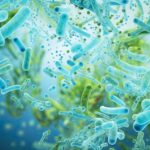What is already known
Targeting gut microbes might offer new possibilities for preventing and treating disease. However, to manipulate the gut microbiota, scientists need to understand the mechanisms that allow commensal bacteria to colonize the gut.
What this research adds
Researchers studied how Bacteroides thetaiotaomicron, one of the most abundant commensal bacterial species, colonizes the human gut. They found that a large domain of the protein Rho, which is essential in regulating gene transcription in bacteria, is critical for B. thetaiotaomicron gene regulation in the gut. The researchers also found that B. thetaiotaomicron responded to the mammalian gut environment by sequestering Rho molecules within membraneless compartments through a process called liquid-liquid phase separation. The formation of liquid-like condensates increased Rho activity, resulting in altered expression of hundreds of genes, including many required for gut colonization.
Conclusions
The findings suggest that other gut microbes use liquid-liquid phase separation to colonize the gut, opening the way for new microbiota-based clinical applications.
The gut microbiota composition varies between healthy people and individuals with certain conditions, so targeting gut microbes might offer new possibilities for preventing and treating disease. To do so, however, scientists need to understand the mechanisms that allow commensal bacteria to colonize the gut. New research shows that the commensal bacterium Bacteroides thetaiotaomicron uses a process called liquid-liquid phase separation of a protein involved in gene transcription to thrive in the mammalian gut.
The findings, published in Science, suggest that other gut microbes use liquid-liquid phase separation to colonize the gut, opening the way for new microbiota-based clinical applications.
B. thetaiotaomicron is one of the most abundant commensal bacterial species in the human gut and has been associated with good health. The microbe is currently being tested in clinical trials as a potential therapeutic for gastrointestinal disorders, so Eduardo Groisman at Yale School of Medicine and his colleagues investigated what allows B. thetaiotaomicron to colonize the mammalian gut.
Bacterial protein
The researchers focused on a bacterial protein called Rho, which is involved in the termination of transcription — the process by which the information in a strand of DNA is copied into a new molecule of messenger RNA. Rho is a highly conserved protein and is essential in regulating gene transcription in bacteria.
B. thetaiotaomicron’s Rho protein differs slightly from other bacteria’s Rho because it contains a domain that lacks a fixed three-dimensional structure. This domain is called a large intrinsically disordered domain, or IDR.
The researchers found that this domain is critical for B. thetaiotaomicron gene regulation in the gut. Indeed, a B. thetaiotaomicron strain lacking IDR strain was quickly outcompeted in the gut of germ-free mice by a strain expressing the domain. The IDR-expressing strain accounted for 95% of the bacterial population of the mice’s gut by day six, the researchers found.
Colonizing the gut
Working in cells grown in a dish and in mice, the team discovered that Rho’s IDR drives a process called liquid-liquid phase separation, which allows the formation of liquid-like condensates containing Rho.
As a response to the mammalian gut environment, B. thetaiotaomicron used liquid-liquid phase separation to sequester Rho molecules within membraneless compartments. This increased Rho activity, resulting in altered expression of hundreds of genes, including many required for gut colonization, the researchers found.
“Our findings establish a critical role for [liquid-liquid phase separation] in host-commensal bacteria interactions, expanding [liquid-liquid phase separation] importance for bacterial physiology,” the authors say.











